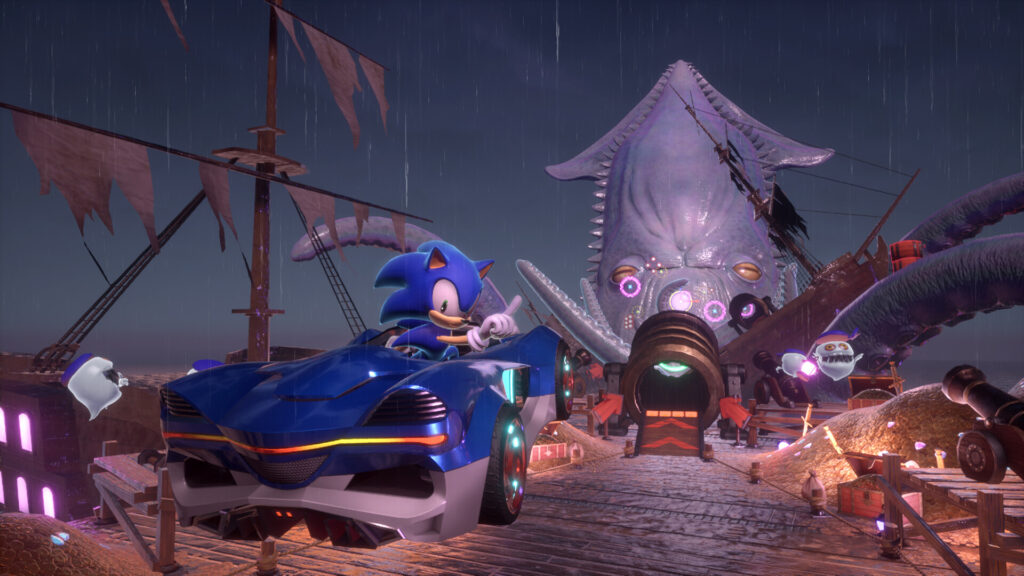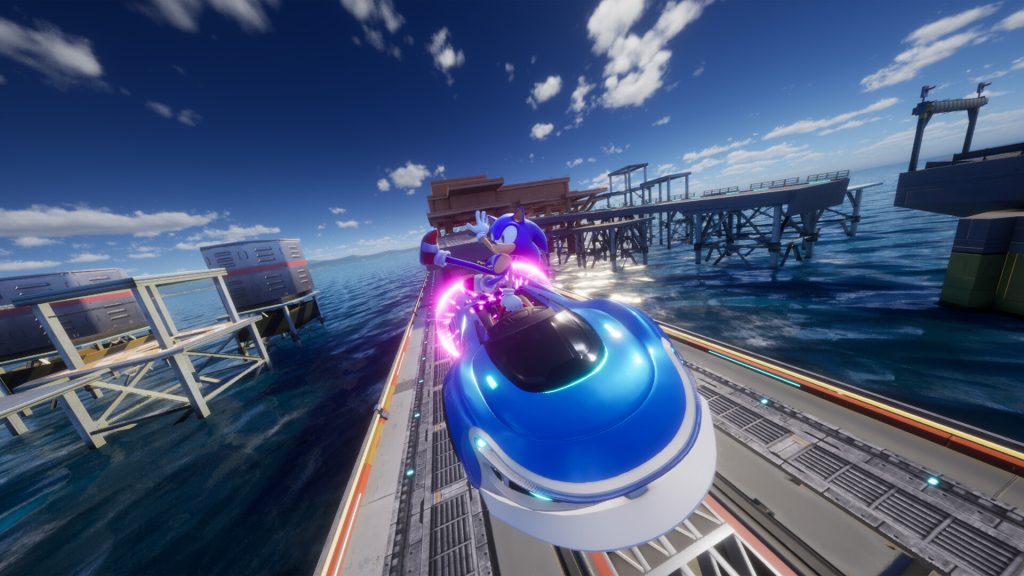Sonic Racing: CrossWorlds – Everything You Need to Know
Sega are feeling confident. With Sonic Racing: CrossWorlds, the Japanese company is aiming squarely at Mario Kart’s crown – and this time, the Blue Blur might just have the engine to do it. Beneath CrossWorlds’ brash, sensory overload lies a surprisingly refined racer, packed with smart mechanics that add real depth to the competition. Sonic Racing is no longer just style over substance; it’s a contender for pole position. So, strap in and get ready: we’re embracing CrossWorlds’ chaos to unpack 15 things you need to know before you buy.
Why is CrossWorlds good?
Sonic’s racing legacy is hit-and-miss. Sonic & All-Stars Racing Transformed’s inventive land, sea, and air transformations and its skill-driven gameplay cements its place amongst the series’ best. In contrast, despite a well-received emphasis on customisation, Team Sonic Racing fell flat through repetitive gameplay and shallow strategy. CrossWorlds aims to fuse the best of Sonic’s racing pedigree whilst finally addressing the series’ long-standing issue: kart feel. With tighter controls, more responsive handling, and a suite of impactful customisations, CrossWorlds is set to be Sonic’s most satisfying racer, and perhaps a title that’ll compete with the best in the genre.
Expect the unexpected
CrossWorlds’ races follow the familiar three-lap format but, in a clever twist, circuits will dramatically shift design from lap-to-lap. First laps deliver the expected karting chaos, with racers jostling for the lead. Yet, on lap two, drivers are launched through Travel Rings into the titular CrossWorlds themselves to race across an entirely different track before returning to the original course for the final sprint. However, third laps are reshaped by new hazards, pathways, and surprises, ensuring the push to the chequered flag remains intense and unpredictable.
Vehicle performance is impacted by Gadgets
[embedded content]
One of CrossWorlds biggest innovations is its Gadgets system. Here, drivers can choose from a suite of seventy different modifiers allowing everything from finely tuning performance to creating hyper-specific builds tailored for certain tracks. Gadgets are divided into categories, with each offering distinct advantages such as ring bonuses, faster charging times, or extra grip on slippery surfaces. The trade-off is that the most powerful Gadgets occupy more slots on each driver’s Gadget Plate, forcing players to strike a balance between raw speed, utility, and finesse.
Building for the unexpected
CrossWorlds’ Travel Rings don’t just reshape the track, but they’ll also complicate how effectively racers can customise their drives. With races thrown into uncertainty during lap two, there’re question marks over how advantageous a hyper-specific build can be for a single course. Is tailoring vehicles for a race’s opening and closing laps the most optimal strategy? Or, should racers create an all-rounder that covers any eventuality? The scuffle for first lap supremacy takes on significance too, given the frontrunner chooses which CrossWorld the pack will dive into – either a known option or a completely random location. In summary: CrossWorlds’ Gadgets system provides strategic depth which, when combined with early-race battles, provide an experience that is novel amongst kart racing games.
Kart types
In Sonic Racing: CrossWorlds, vehicles – collectively known as Machines – come in five types: Speed, Acceleration, Handling, Power, and Boost. The game’s players aren’t bound to a specific type either, despite their skillsets falling within identically-named categories. Plus, for the first time in a Sonic racing game, players can take to the track in traditional karts and Extreme Gear, the latter contained exclusively within Boost type machines, comprising air boards which originate from the Sonic Riders universe.
Robust vehicle customisation
With more than 70,000 possible combinations, Sega is going big on customisation in Sonic Racing: CrossWorlds. Racers can personalise everything from liveries and decals, to wheels, horns, auras, parts, and textures, providing an exhaustive list of cosmetic adjustments. Moving beyond aesthetics, racers can also fuse parts from different vehicle classes, mixing the front of one Machine type with the back-end of another. The result is a drive that blends both appearance and performance, adopting the statistical strengths of each half whilst creating something uniquely eye-catching.
Racetrack variety
Sonic Racing: CrossWorlds will feature forty-five racetracks – twenty-four main circuits, with an extra six tracks added via Season Pass, plus fifteen CrossWorlds. Sixteen of the main courses are original locations, and twenty-two are inspired by past Sonic games, including some from Sonic’s 2D heyday. The game’s main circuits are split across seven four-race Grand Prix, with the first three races featuring middle-lap CrossWorlds. The finale will be a medley of the three courses already raced.
The CrossWorlds in more detail

We’ve already discussed the game’s CrossWorld mechanic, but the locations themselves deserve a spotlight. Each is inspired by past Sonic titles, rethought as middle lap detours. Sky Road is a candy-coloured airway lifted from Team Sonic Racing, while Holoska reimagines Sonic Unleashed’s icy tundra. Digital Circuit recalls a level from Shadow the Hedgehog, with Cyber Space originating from Sonic Frontiers’ Eternal Highway. Racers who want consistency can disable the CrossWorlds entirely, whilst the inverse is available in select modes that will allow main tracks to appear as CrossWorld laps.
The Rival System
Regardless of Gadgets, customisations, or kart type, Sonic Racing: CrossWorlds ensures there’s always one racer capable of pushing players to the limit. The Rival System picks a CPU opponent to be more competitive than the player, raising the stakes in every lap. Rivals aren’t only tough to beat, but they’ll talk trash every time they pull alongside. Before each race, players can choose between two Rivals, with one offering a sterner test than the other. Defeating a Rival awards a Chaos Emerald, with a Super Race unlocking should seven Emeralds be collected.
There’re numerous options for local multi-player
Sonic Racing: CrossWorlds supports local play with up to four split-screen racers on the same device. Race speed is customisable alongside team size, circuits, CrossWorlds, AI difficulty, item drop rates, and more, ensuring each event is perfectly tailored for each competitor. The new Race Park is an offline, multi-player ‘party’ mode where teams of players compete in various race modes, completing challenges, earning points, and vying for couch supremacy.
Online game modes
Sonic Racing: Crossworlds supports online cross-platform play for up to twelve players. The biggest draw to competing online is World Match, a test of skill and racecraft through various stages to earn Rank Points and rise through the world rankings. Ranks range from E to A, with those rising to the very top being invited to compete in a Legends league. Gadgets and other prizes are the reward for every rise in rank.
Single player modes
The core single player offering in Sonic Racing: CrossWorlds will be Grand Prix mode. There’lll be seven separate Grand Prix at launch, each with four rounds, with points tallied based on finishing position. Elsewhere, Time Trial mode puts the focus on pure speed. Unlike Mario Kart’s approach, CrossWorlds requires drivers to collect boost items each lap and then decide when best to use them. Gadgets can also be equipped, raising the possibility of hyper-optimised builds that’ll be required to reach those elusive S-tier times.
Platforms, release date, and price

Sonic Racing: CrossWorlds will be available to play on PlayStation 4 and PlayStation 5, Xbox One and Xbox Series X|S, Nintendo Switch 1 and Switch 2, and PC via Steam and the Epic Games Store. Set to launch September 25th, the game’s Standard Edition retails at £64.99 / $69.99. A Digital Deluxe Edition which includes all Season Pass content is also available, priced at £79.99 / $89.99.
Pre-order bonuses
Pre-ordering either CrossWorlds’ Standard Edition or Digital Deluxe Edition nets three bonus items: a new racer, a machine, and a decal, all three themed on Sonic Unleashed’s Werehog. The Digital Deluxe Edition also comes with 72-hour early access.
PC requirements
The minimum PC requirements as per the game’s Steam listing detail an Intel Core i5-3470 or AMD Ryzen 3 1200 processor and an NVIDIA GeForce GTX 1630, 4GB or AMD Radeon R9 380, 4GB or Intel Arc A380, 6GB GPU. To experience Sonic and friends at their most high-octane on your PC, your rig will need the following: an Intel Core i7-8700K or AMD Ryzen 5 2600 processor and an NVIDIA GeForce GTX 1660 Ti, 6 GB or AMD Radeon RX 5600 XT, 6 GB GPU. Whether running at minimum, recommended, or somewhere in between, your PC will need at least 12GB RAM.


Comments are closed.